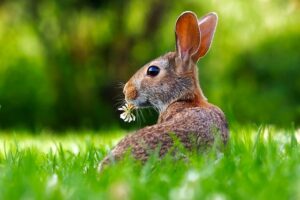 Greetings, readers. After taking a break to address cult issues in my blog yesterday, “Speaking of ‘Way’ Stories …” welcome back to the ongoing series of articles, “Caring for Mother Nature.” My friend, the author and naturalist, Peggy Sias Lantz., writes these for her church newsletter, and I offered to share them with you guys. We’re on the tenth one already!
Greetings, readers. After taking a break to address cult issues in my blog yesterday, “Speaking of ‘Way’ Stories …” welcome back to the ongoing series of articles, “Caring for Mother Nature.” My friend, the author and naturalist, Peggy Sias Lantz., writes these for her church newsletter, and I offered to share them with you guys. We’re on the tenth one already!
Thanks for your interest in this most essential topic: taking care of Mother Earth with all her creatures great and small.
Today, Peggy clues us in on one of our wonderful earthly cohabitants: the rabbit. Here in Florida, Hoyt, my husband, and I have frequent visits to our yard from one type of rabbit often seen around our lakeside neighborhood: the marsh rabbit. Keep reading for de-tails (pun intended).
Mother Earth’s Children: Rabbits
by Peggy Sias Lantz
The Easter Bunny. Peter Rabbit. Br’er Rabbit. All kinds of rabbit stories out there! Must be something about rabbits …
Well, there is. They’re cute, fluffy, small, make good pets, and are fun to have in the yard.
They are also good to eat. In fact, they are so good to eat that they are a favorite prey of so many other creatures that most baby bunnies don’t survive the nest, even though mama rabbit visits the nest twice a day to nurse her brood in an effort to keep them hidden.
What about rabbits’ nests, babies, and life cycle?
Mama rabbit’s nest is a scrape on the ground, called a “form,” usually in the open in some slight depression. She paws it into a bowl and lines it with leaves and grasses and the soft fur from her breast. Then she makes a blanket of leaves and grasses that she covers up the nest with. When the babies are born, less than 30 days after mating, their eyes are closed and their ears are flat against their heads. Mom covers them with the “blanket” and leaves them alone except for the twice-a-day nursing visits.
But the babies mature fast, and by the time they’re three weeks old, they are on their own, feeding on almost anything green and growing. And they can mate in three months!
Everything about a rabbit’s life is fleeting – mating takes seconds, gestation is short, labor is quick, and they can be bred again immediately after birthing. Even its life is fleeting. Rarely does a rabbit live as long as a year. While still in the nest, they can drown from heavy rain, be killed by mowers, eaten by predators, or die from disease or parasites.
But more than anything, their lives are shortened by predators. I think maybe their entire purpose in life is to feed carnivores. Fortunately for the predators, they breed like – well, like rabbits, and keep hawks, foxes, coyotes, owls, snakes, and dogs fed.
Florida’s rabbit species
Florida is home to two species of rabbit – the cottontail rabbit and the marsh rabbit. The marsh rabbit is slightly smaller than the cottontail, has darker brown fur, shorter ears and legs, and its tail is brown, not white. (Did you know that the little tail of a rabbit is called a scut?)
The marsh rabbit lives close to water, feeds on water plants like cattails and pennywort, and can swim well. Other than that, its life is much like the cottontail’s life.
Both need just a few acres for survival.
If you enjoy watching rabbits in your yard, make a small brush pile in the corner somewhere, leave a few bushes for shelter, and before you mow, search for small brown spots a few inches across; it may be the blanket over a “form” for a nest of baby bunnies.
—END—
Thanks for reading!
Your writer on the wing,
Charlene








Kathleen Brandt
I never knew some rabbits could swim!